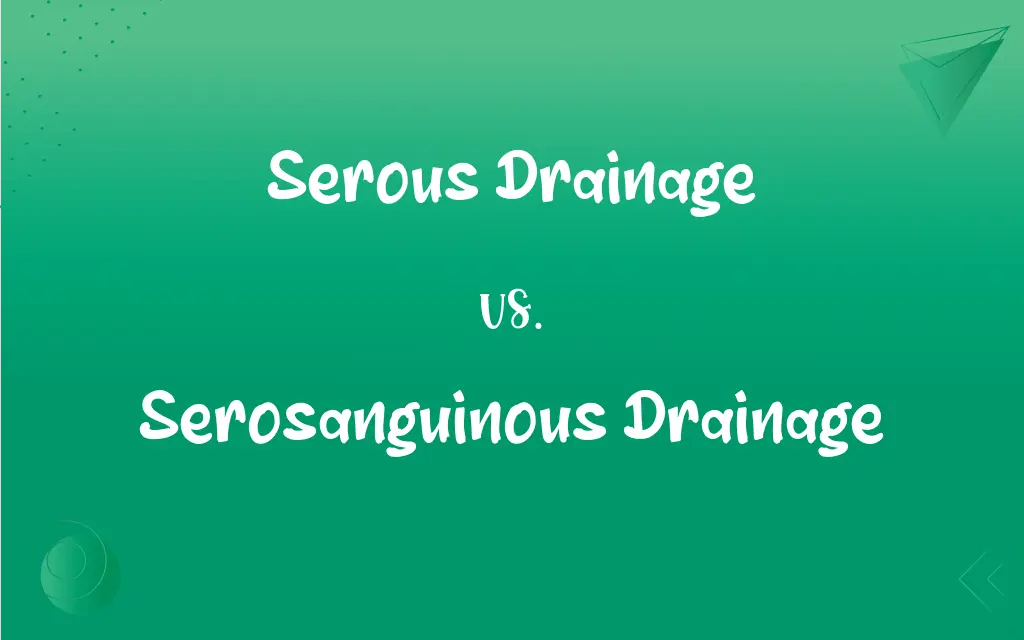Serous Drainage vs. Serosanguinous Drainage: What's the Difference?
Edited by Aimie Carlson || By Janet White || Published on February 21, 2024
Serous drainage is clear, thin, and watery, typical of normal healing wounds, while serosanguinous drainage is pink to red, indicating a mix of serous fluid and blood, common in new wounds.

Key Differences
Serous drainage is a clear, thin, watery fluid that is commonly seen in the early stages of wound healing. It is a normal part of the healing process, indicating minimal tissue damage and inflammation. Serosanguinous drainage, however, is a combination of blood and serous fluid. This type of drainage is pink to light red and is often observed in new wounds or during active healing phases where small blood vessels may be involved.
The appearance of serous drainage is typically transparent and can be slightly yellowish, resembling the fluid found in blisters. It's composed of proteins, white blood cells, and other wound healing elements. On the contrary, serosanguinous drainage includes these components plus red blood cells, which give it a pinkish or reddish tinge. It's usually seen in wounds that are healing but still have minor bleeding occurring.
Serous drainage is generally a good sign in wound healing, indicating that the body's immune system is functioning properly and the wound is being cleansed. In contrast, while serosanguinous drainage can also be a normal part of the healing process, excessive or prolonged serosanguinous drainage might be a sign of complications, such as delayed healing or infection.
In terms of volume, serous drainage is usually minimal and not a cause for concern. However, a large amount of serosanguinous drainage, especially if it's increasing or accompanied by other symptoms like pain, could indicate a problem, such as wound dehiscence or infection, requiring medical attention.
Serous drainage typically indicates a stable, healing wound, whereas serosanguinous drainage suggests a wound that is still actively healing and may need closer observation. Both types of drainage require proper wound care and hygiene to promote healing and prevent infection.
ADVERTISEMENT
Comparison Chart
Appearance
Clear, thin, watery
Pink to red, indicating a mix of serous fluid and blood
Indication
Normal healing, minimal tissue damage
Active healing, possible involvement of small blood vessels
Composition
Proteins, white blood cells, other healing elements
Serous fluid plus red blood cells
Normalcy in Wound Healing
Indicates good healing progress
Normal but may signal complications if excessive
Clinical Significance
Minimal and not concerning
Requires monitoring for signs of complications
ADVERTISEMENT
Serous Drainage and Serosanguinous Drainage Definitions
Serous Drainage
"It's a sign of normal inflammation and immune response in wound healing."
The serous drainage from the scrape on her knee was a good sign of healing.
Serosanguinous Drainage
"It's common in wounds that are healing but might still have minor vascular involvement."
Given the surgery's nature, serosanguinous drainage was not unexpected at this stage.
Serous Drainage
"This type of drainage is typically seen in the early stages of wound healing."
As expected, the minor cut was producing serous drainage.
Serosanguinous Drainage
"This type of drainage can signal a need for closer wound monitoring."
The increase in serosanguinous drainage prompted the nurse to check for signs of infection.
Serous Drainage
"Serous drainage is composed primarily of proteins and white blood cells."
The clear serous drainage indicated minimal infection risk.
Serosanguinous Drainage
"Serosanguinous drainage is a mixture of blood and the clear serous fluid, indicating new or active wound healing."
The pinkish serosanguinous drainage from the surgical site was expected on the first day.
Serous Drainage
"Serous drainage is indicative of a wound that is being properly cleansed."
The clear, serous drainage showed the body was effectively clearing debris from the wound.
Serosanguinous Drainage
"It often appears pink to light red, suggesting minor bleeding in the wound."
The dressing was stained with serosanguinous drainage, showing some ongoing healing.
Serous Drainage
"Serous drainage is a clear, watery fluid that naturally occurs in healing wounds."
The surgeon noted only serous drainage from the post-operative wound, indicating good healing.
Serosanguinous Drainage
"Serosanguinous drainage includes red blood cells along with wound healing elements."
The presence of serosanguinous drainage indicated a small amount of blood mixed with the wound fluid.
FAQs
Is serous drainage a good sign?
Yes, it typically indicates healthy wound healing.
What causes serous drainage?
It's part of the body's natural inflammatory and immune response.
What does serosanguinous drainage look like?
Pink to red, a mix of blood and serous fluid.
Can serosanguinous drainage indicate a problem?
If excessive or prolonged, it may signal complications.
When should I worry about serosanguinous drainage?
If it's increasing, accompanied by pain, or lasts longer than a few days.
How long does serous drainage last?
It can last several days, depending on the wound's healing.
What should I do if I see serous drainage?
Keep the area clean and monitor; usually, it's not a concern.
Should I be concerned about clear serous drainage?
Generally, no, unless it's excessive or changes in character.
What is serous drainage?
A clear, thin, watery fluid indicating normal wound healing.
Does serosanguinous drainage mean infection?
Not necessarily, but it should be monitored for infection signs.
Is serosanguinous drainage common after surgery?
Yes, especially in the initial days post-surgery.
Why does serosanguinous drainage occur?
Due to minor bleeding in a healing wound.
Can serosanguinous drainage lead to infection?
If not properly managed, it can increase the risk of infection.
Does serous drainage contain blood?
No, it's typically clear and blood-free.
Can both types of drainage occur in the same wound?
Yes, depending on the stage of healing.
How can I differentiate between serous and serosanguinous drainage?
By the color: serous is clear, serosanguinous is pink to red.
What's the best care for a wound with serosanguinous drainage?
Cleanliness, proper dressing, and monitoring for any signs of complication.
What does a lot of serous drainage indicate?
It might indicate a large wound or more active healing.
Is serosanguinous drainage painful?
It's not painful itself, but the wound might be.
What are the components of serous drainage?
Mainly proteins and white blood cells.
About Author
Written by
Janet WhiteJanet White has been an esteemed writer and blogger for Difference Wiki. Holding a Master's degree in Science and Medical Journalism from the prestigious Boston University, she has consistently demonstrated her expertise and passion for her field. When she's not immersed in her work, Janet relishes her time exercising, delving into a good book, and cherishing moments with friends and family.
Edited by
Aimie CarlsonAimie Carlson, holding a master's degree in English literature, is a fervent English language enthusiast. She lends her writing talents to Difference Wiki, a prominent website that specializes in comparisons, offering readers insightful analyses that both captivate and inform.







































































